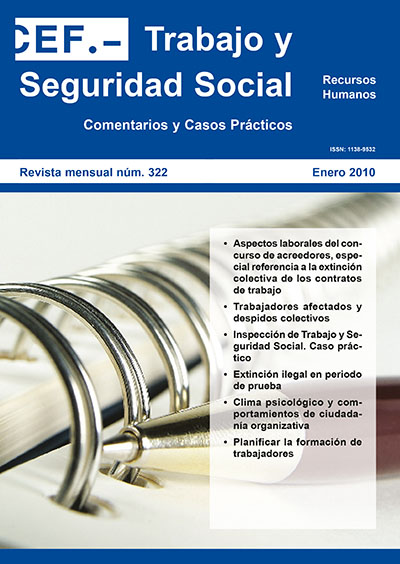Planning: the key to success in staff training
DOI:
https://doi.org/10.51302/rtss.2010.5357Keywords:
ongoing education, planning process, needs assessment, evaluation of results, training evaluation methods, training in labor arrangementsAbstract
Every business plan has to be planned, in a more or less detailed and constant way, to ensure that, at least in a theoretical context and in anticipation, the resources are available in form, cost and the most appropriate time possible with the desire to act efficiently. If this is important in the majority of the actions of a company, it is especially important in the training policy for employees. Without sufficient planning, the company risks that its investment in training becomes more expenses. In this paper, we discuss not only the crucial nature of this work prior to the development of training actions, but also the most frequently instruments used in each phases of the planning process, including the most difficult: its evaluation.
This is the specific stage which will provide data to argue the continuation of the learning processes selected, or the need to correct the localized deviations of the results that had been planned to obtain. Therefore, it's important to choose the suitable evaluation method for the specific purpose that the company wants to achieve. Some of the targets will have a quantitative nature, and will present the possibility of drawing conclusions from commonly accepted indicators in the financial area (which, usually, decides whether the continuation of the training policy), that is the case of «return on investment», or ROI. Others will be qualitative in nature, and therefore much more complex to measure and treat, but equally important for a company that has to act and adapt to a dynamic and changing environment.
Finally, we make a brief reference to the ways in which ongoing education is reflected in labor arrangements, and the possibility that, through their representatives in the company, the workers get involved in the planning of such training.
Downloads
References
Albáizar, R. [2004]: Manual de Formación. CISSPRAXIS, Valencia.
Bainbridge, S. y Murray, J. [2001]: «Las disposiciones políticas y legales que han desarrollado la política de formación en la Unión Europea». Boletín CINTERFOR, n.º 153, págs. 177-211.
Brinkerhoff, R.O. [2006]: Telling Training´s Story. Berret-Koehler, San Francisco.
Comisión de las Comunidades Europeas [2001]: Comunicación «Hacer realidad un espacio europeo del aprendizaje permanente». Luxemburgo.
Confederación Española de Organizaciones Empresariales, CEOE [2001]: La formación en las empresas españolas. Situación, tendencias y expectativas. Madrid.
Córdova, P. [2007]: «Evaluación y certificación de los organismos de formación y consultoría». Dirigir Personas, n.º 45, págs. 44-45. AEDIPE, Barcelona.
De la Torre, I. [2000]: «La dimensión social del capital humano. Formación ocupacional y formación continua». Papeles de Economía Española, n.º 86, págs. 266-279.
Eguiguren, M. [2001]: «Cómo convertir su Departamento de Formación en un centro de beneficios». Seminario CISSPRAXIS. Especial Directivos. 30 y 31 de mayo, Madrid.
Fernández-Salinero Miguel, C. [1999]: «El diseño de un plan de formación como estrategia de desarrollo empresarial. Estructura, instrumentos y técnicas». Revista Complutense de Educación, Vol. 10, n.º 1, págs. 181-242. Universidad Complutense de Madrid.
Fundación FORCEM [1999]: «Memoria balance: I Acuerdo Nacional de Formación Continua. 1993-1996». Madrid.
Fundación Tripartita para la Formación en el Empleo [2003]: «Memoria 2000 de la Comisión Paritaria Territorial de Andalucía».
– [2004]: «Formación Continua. Competitividad y cohesión social». Recopilación de las intervenciones del Encuentro de Verano 2003, San Lorenzo de El Escorial, Madrid.
– [2006]: «Iniciativas de formación». Madrid.
Kirkpatrick, D.L. [1999]: «Evaluación de acciones formativas». EPISE.
McKinney, D. [2007]: «Desafíos de la evaluación de impacto en la educación experimental». 5.º Encuentro Nacional de Educación Experimental. Chinuauta, Colombia, 3 de noviembre. On-line: http://www.compensar.com/doc/edu/VencEduExp/01DesEvaImpProFor/Ponencia%20Dra%20Debra.pdf
Organización Internacional del Trabajo, OIT [2002]: «Programa Global para el Empleo».
Phillips, J.J. [1997]: Return on Investment. Gulf Publishing Co., Houston/Texas.
Pineda, P. [1998]: «Cómo evaluar el impacto de la formación en la empresa». Seminario CISSPRAXIS. Especial Directivos. 15 y 16 de octubre, Barcelona.
Puchol, L. [1999]: Dirección y Gestión de Personal. ESIC, Madrid.
Saavedra, I. [1998]: Motivación y comunicación en las relaciones laborales. Pirámide, Madrid.
Torras, L. [1997]: «Aprender: la ventaja competitiva más sostenible en el tiempo». Alta Dirección, n.º 191, págs.13-19.
Recursos en la web
Ministerio de Trabajo e Inmigración/Seguridad Social:
http://www.mtas.es/es/seg_soc/index.htm
Encuesta de Calidad de Vida en el Trabajo: http://www.mtas.es/estadisticas/ecvt/welcome.htm
Estadística de Convenios Colectivos: http://www.mtas.es/estadisticas/cct/welcome.htm


















